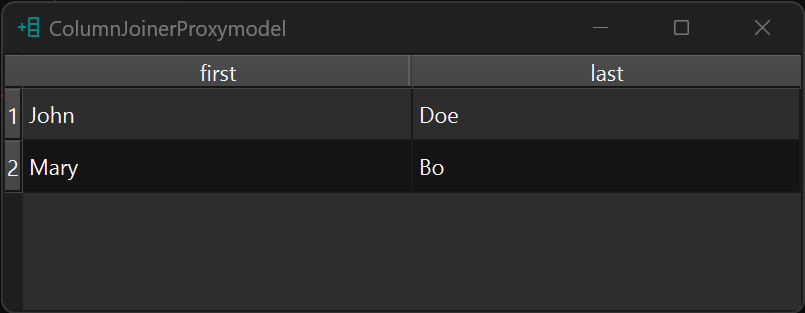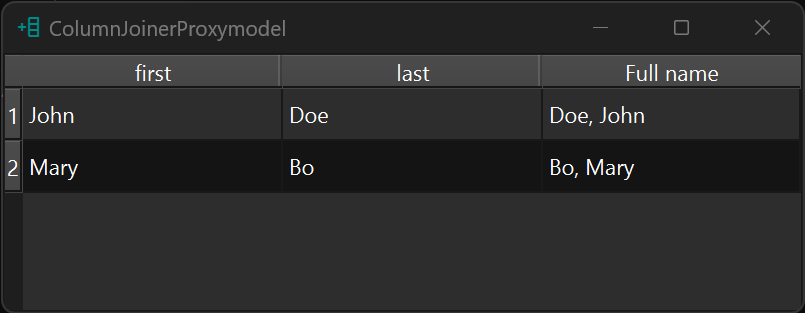ColumnJoinerProxyModel
Qt Base Class: QAbstractProxyModel
Signature: QAbstractProxyModel(self, parent: Optional[PySide6.QtCore.QObject] = None) -> None
Base classes
| Name | Children | Inherits |
|---|---|---|
| AbstractProxyModel prettyqt.core.abstractproxymodel |
⋔ Inheritance diagram
graph TD
1473290761840["itemmodels.ColumnJoinerProxyModel"]
1473299891152["core.AbstractProxyModel"]
1473299903840["core.AbstractProxyModelMixin"]
1473299890176["core.AbstractItemModelMixin"]
1473299815024["core.ObjectMixin"]
140713234304496["builtins.object"]
1473289061840["QtCore.QAbstractProxyModel"]
1473289050128["QtCore.QAbstractItemModel"]
1473288842240["QtCore.QObject"]
1473291690208["Shiboken.Object"]
1473299891152 --> 1473290761840
1473299903840 --> 1473299891152
1473299890176 --> 1473299903840
1473299815024 --> 1473299890176
140713234304496 --> 1473299815024
1473289061840 --> 1473299891152
1473289050128 --> 1473289061840
1473288842240 --> 1473289050128
1473291690208 --> 1473288842240
140713234304496 --> 1473291690208🛈 DocStrings
Bases: AbstractProxyModel
Proxy model which joins the contents of several columns.
The columns are joined based on a formatter and appended to the end of the model as a new column.
The formatter must look like {0} - {1}: {4}.
The format codes are then populated with the content of given columns,
in this case it would be {Text of column 0} - {Text of Column 1}: {Text of Column 4}
Example
table.proxifier.join_columns(formatter="{0} - {2}", header="New column")
table.show()
# or
model = MyModel()
proxy = ColumnJoinerProxyModel()
proxy.set_source_model(model)
proxy.add_column(formatter="{0} - {2}", header="New column")
proxy.add_column(formatter="{4}: {5}", header="Another column")
table.set_model(proxy)
table.show()
Source code in prettyqt\itemmodels\proxies\columnjoinerproxymodel.py
21 22 23 24 25 26 27 28 29 30 31 32 33 34 35 36 37 38 39 40 41 42 43 44 45 46 47 48 49 50 51 52 53 54 55 56 57 58 59 60 61 62 63 64 65 66 67 68 69 70 71 72 73 74 75 76 77 78 79 80 81 82 83 84 85 86 87 88 89 90 91 92 93 94 95 96 97 98 99 100 101 102 103 104 105 106 107 108 109 110 111 112 113 114 115 116 117 118 119 120 121 122 123 124 125 126 127 128 129 130 131 132 133 134 135 136 137 138 139 140 141 142 143 144 145 146 147 148 149 150 151 152 153 154 155 156 157 158 159 160 161 162 163 164 165 166 167 168 169 170 171 172 173 174 175 176 177 178 179 180 181 182 183 184 185 186 187 188 189 190 191 | |
add_mapping(header: str, formatter: str, flags: constants.ItemFlag | None = None)
Add a new column to the table.
Parameters:
| Name | Type | Description | Default |
|---|---|---|---|
header |
str
|
Label used for the section header. |
required |
formatter |
str
|
String formatter (example "{0}: {1}") |
required |
flags |
ItemFlag | None
|
ItemFlags for new column |
None
|
Source code in prettyqt\itemmodels\proxies\columnjoinerproxymodel.py
⌗ Property table
| Qt Property | Type | Doc |
|---|---|---|
objectName |
QString | |
sourceModel |
QAbstractItemModel |

